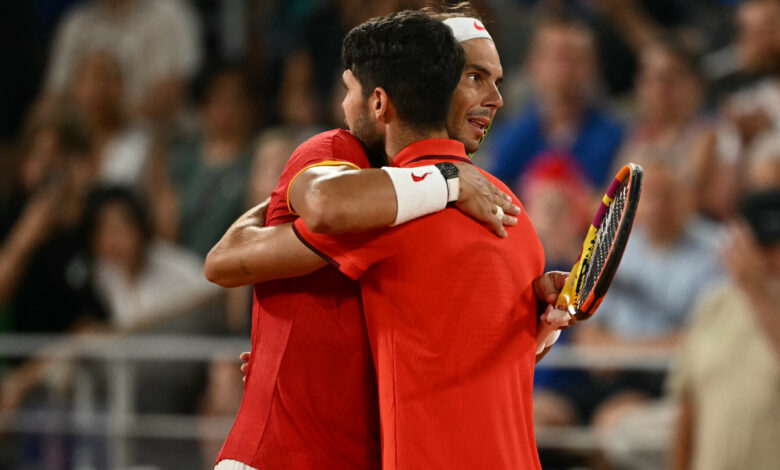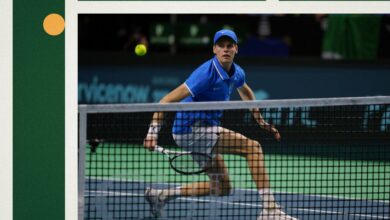Nadalcaraz’s irresistible power falls prey to immovable object at Olympics

A clap of thunder and a muffled boom. A clap of thunder and a muffled boom. A clap of thunder and a muffled boom. Another muffled boom. Silence.
The sounds of ball on racket under the roof at Philippe-Chatrier, and the sounds of the irresistible force of Carlos Alcaraz and Rafael Nadal meeting the immovable object of Rajeev Ram and Austin Krajicek, as the feel-good tennis story of the Paris 2024 Olympics came to an end on Wednesday. The American pair of doubles specialists triumphed 6-2, 6-4.
The result marked the end of the doubles partnership between ‘Nadalcaraz’ and Roland Garros, which had entertained spectators throughout, despite Nadal in particular constantly saying that they were not playing at their best.
“We’re not used to playing doubles and I think that made a difference because they always play doubles,” he said. “They did a lot of things well and we didn’t.”
“We’re not doubles players,” Alcaraz said. “When you have a little doubt, it’s not easy. We’ve only played together a few times and that made a difference.”
In a display of spot serving, tightly honed patterns and an innate mastery of doubles geometry, Ram and Krajicek put on a clinic that guaranteed they’ll be playing for an Olympic medal later this week. Even Nadal and Alcaraz, two of the best late-career and all-career volleyers in men’s singles, looked half a second too slow and just a little off their game.

The intelligence of Ram and Krajicek was too much for Nadal and Alcaraz to handle (Clive Brunskill/Getty Images)
The biggest complaint of the recreational tennis player is that old frustration. I am so much better than them. They just get the ball back. It’s not real tennis. I was the one trying to win the match.
Normally they also talk about ‘pushers’, but in a battle between 26 Grand Slam singles titles and seven Grand Slam doubles titles, let’s not talk about that.
The battle at the heart of that lament is talent versus specialization; the possession of weapons and the use of tools. On a court where Alcaraz and Nadal are accustomed to unleashing their arsenals and unpacking their boxes regardless of who is on the other side, they were disarmed and jaded in equal measure by the experience, knowledge and pattern of two players who occasionally miss shots but occasionally make poor decisions.
That series of thunders and booms came at 2-5 in the first set, when Alcaraz was trying valiantly to hold serve and stay in the set. He unleashed his forehand again and again, trying to beat Ram and Krajicek the way he has beaten the entire ATP Tour for the past two years. The ball kept bouncing back. If it had come with a speech bubble, like a cartoon gun with a piece of cloth labeled “bang,” it would have read: “Hey Carlos. Hey Rafa. You guys are great players. But we can do this all day long.”
One pop too many and Alcaraz hit something between a groundstroke and a pick-up volley out of the court. Two double faults later it was 6-2 and the set was gone.
Ram and Krajicek turned even their most obvious limitation into a strength. Alcaraz and Nadal would one-handedly batter Ram’s backhand, but he would chisel it back, forcing them to aim further and further. They would miss. He would win the battle. Nadal’s strange sledgehammer forehand, spinning and dipping, would get through, but would usually come back and force another ball. The old reliables would turn into mediocres. The incredibles would turn into nothing but good ones. Nadal and Alcaraz were caught up in another all-too-familiar feeling for the recreational tennis player: the feeling of playing against people who, it seems, are playing a different sport.
Exactly the feeling they have given countless opponents on the singles court over the past 20 years.

‘Nadalcaraz’ was no match for the experience of Ram and Krajicek (Patricia de Melo Moreira/AFP via Getty Images)
Tennis’ top brass argue that doubles needs singles players. New ATP rules have made it easier for higher-ranked singles players to compete, encouraging matches between the best in both disciplines and, the tours suggest, adding the excitement, competition and crowd interest that doubles players alone can’t draw.
Ram and Krajicek felt the cauldron of it all as they served for the match at 5-4. Volleys that had been tight and tight as a drum were slackening. Ram crouched at the net and took a breath after Krajicek hit his first double fault of the match, the fans wanting another go from Nadalcaraz, chanting and encouraging them to keep going, asking them to do what they have done so many times on this court. Alcaraz screamed a return winner for 15-40. The innate talent bubbling up, suppressed for so long.
They suppressed it. Alcaraz threw a difficult return up; Ram hit it at a sharp angle into the crowd. Alcaraz and Nadal threw volleys back to Ram and Krajicek. Ram and Krajicek threw volleys into space, into difficult places.
Krajicek went down on break point. He hit his spot on the serve. Then he hit it again, further and further away from a stretching Alcaraz, to win the match.
In reality it was 3-3 when the final blow fell, again on Alcaraz’s serve.
Krajicek hit two balls at opposite ends of his wingspan, using the corners of the court to tempt Alcaraz to overextend. Ram positioned himself in the ad-court alley, forcing Alcaraz to hit his forehand first and then push a forehand wide as he re-targeted that backhand.
Alcaraz hit the ball up the middle. Krajicek got it back. Alcaraz went even harder, hit a lucky net cord and the Americans had an easy hit. And to really rub it in, Ram stepped outside a serve and hit a forehand return to the edge of the line, leading to a dispute over ball markings and trajectories that probably shouldn’t happen at 0-40 in an Olympic quarterfinal, but happened anyway because that’s how it works at Roland Garros.
At 3-4 the match was effectively over, despite that final lightning strike in the last game. But it was that seventh game that best illustrated what those sounds had made resound in the eighth game of the first set. Thunder and sound and fury are majestic to behold. Silence them, and the rest is silence.
(Top photo: Carl de Souza/AFP via Getty Images)




